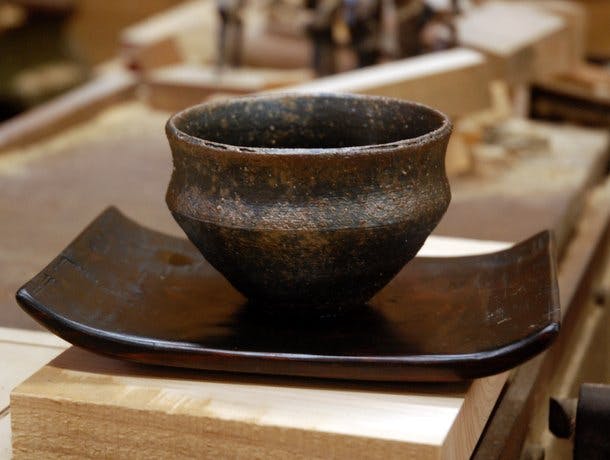
mr. iwamitsu, wood carver
Discover the art of wood carver Mr. Iwamitsu in rural Western Honshu, Japan, and how his hand-carved plates and bowls add a unique character to Japanese tableware. Learn about the traditional techniques and the seasonal transformation of his artisanal wooden vessels when used for serving Japanese cuisine.
Mr. Iwamitsu has worked a wood carver in the rural Western Honshu area of Japan for over three decades. I first came across his breathtaking work several years ago in the studio of the noted Karatsu potter Jinenbo Nakagawa. As Jinenbo-san served me tea in one of his dramatic swirled rice ash-glazed cups, he commented on the wooden saucer holding it -- Mr. Iwamitsu's saucer. "Doesn't my cup look great on this dish?" he said. Indeed. I made a mental note right then to visit the wood carver. I finally got my chance.
In Japanese cuisine, presentation is as integral to the cooking as the ingredients themselves. Dishes don't match each other like they typically do in the West, they match the foods they hold. Rather than dinner served on a uniform set of china, Japanese tableware is a play of colors, shapes and materials that reflect the seasons, the tone of the meal and the whimsy of the cook. Vessels are fashioned from pottery, porcelain, wood or even washi, handmade paper. Food "wears" tableware the way we might don clothes. Jinenbo-san took as much pleasure in the play between his cup and Mr. Iwamitsu's plate as he did in sipping his terrific green tea.
Mr. Iwamitsu invited me to his modest two-room gallery in the city of Yamaguchi. He was a small, gentle man in his mid-fifties, wearing a yellow work shirt, baseball cap and stubbly close-cropped white beard. He spoke in quiet, measured tones, walked in quiet, measured steps. His hand-carved plates, trays and bowls were arresting, richly burnished but simple, sublime vessels that seemed as peaceful as the man who created them. I asked Mr. Iwamitsu if I could visit his workshop to learn how he fashioned his vessels, not just admire the finished product. "No, no," he said softly. I couldn't see his studio. "It's chaos," he said, afraid it was too disheveled for guests.
But I asked him again. We spoke for a while. Eventually, he agreed. A friend and I followed his car out of the city, up a winding road that led to a thick, mountainous forest. We pulled into a narrow dirt driveway to arrive at his home: A secluded house and workshop in a clearing, enveloped by 60-foot cedars.
We passed a stack of rectangular cypress blocks -- raw material for his vessels -- as we entered his workshop. The simple structure had the look of craftsmanship not chaos: tools scattered on a long workbench, sawdust and wood shavings on the floor, notes, designs and postcards pinned to the wall. Once inside, Mr. Iwamitsu explained his art. He conjures his plates and bowls to life with a set of twenty chisels. Once he sands the pieces, he applies six coats of stain he mixes himself, then varnishes with a walnut varnish. He can carve five vessels at day at the most. Including time for drying, it takes six weeks to turn a block of wood into a finished plate.
His completed vessels are only the beginning, though. "When you eat on my plates," he said quietly, "the colors start to change." Food transforms the ebony hue. Red undertones begin to reveal themselves. His plates come to life, taking on a character as unique and individual as you or me. The character of Japanese tableware.
